In the heart of lush mangroves and serene wetlands, where the whispers of nature intertwine with the gentle rustle of leaves, there exists a creature revered for its elegance and spiritual significance—the Sacred Kingfisher (Todiramphus sanctus).
With its iridescent azure plumage and piercing gaze, this avian monarch has captivated the imaginations of cultures across the globe, becoming a symbol of tranquility, wisdom, and divine intervention.
Nestled within the intricate tapestry of folklore and mythology, the Sacred Kingfisher holds a revered status among indigenous communities, often embodying a messenger between the earthly realm and the spirit world.
Its presence is believed to herald auspicious times and offers guidance to those in need, its ethereal song weaving through the fabric of existence like a celestial melody.
Join us to delve into the enchanting realm of the Sacred Kingfisher, uncovering its enigmatic allure and unraveling the threads of its mythological legacy.
Key Physical Characteristics of the Sacred Kingfisher
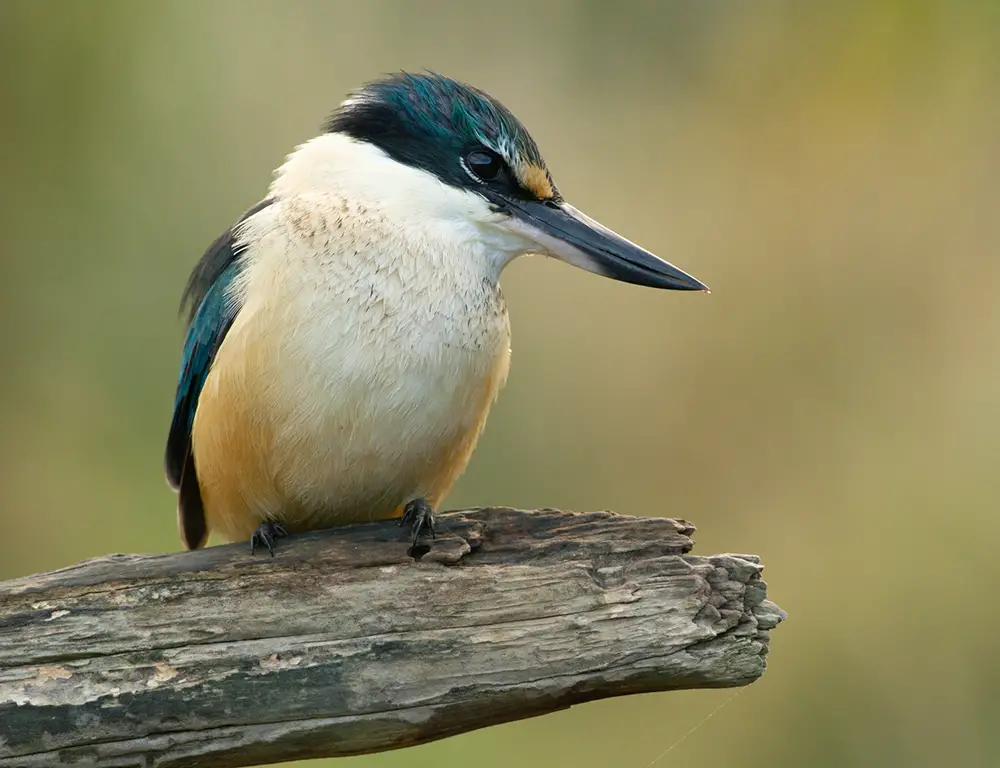
The Sacred Kingfisher is a striking bird renowned for its vibrant plumage and distinctive features. Here, we delve into its vital physical characteristics, which contribute to its unique beauty and remarkable adaptations for survival.
Size and Shape
The Sacred Kingfisher is a medium-sized bird, measuring approximately 19 to 23 centimeters (7.5 to 9 inches) in length.
It possesses a compact, stocky build with a short neck and a large, slightly flattened head. Its sturdy bill is long and dagger-like, ideally suited for catching and dispatching its aquatic prey.
Plumage
One of the most captivating aspects of the Sacred Kingfisher is its iridescent plumage. The bird’s upperparts are adorned with a stunning combination of deep azure, emerald green, and rich chestnut tones, creating a mesmerizing sheen in the sunlight.
Its underparts are predominantly white, with subtle hints of turquoise on the chest and belly. The wings and tail feature bold black and white markings, adding to its visual appeal.
Head and Facial Features
The Sacred Kingfisher’s head is adorned with a distinctive black mask that extends from its bill to its eyes, giving it a masked appearance.
Its eyes are large and dark, providing excellent vision for hunting in daylight and low-light conditions. Above each eye, a narrow white stripe contrasts sharply with the surrounding plumage, accentuating its piercing gaze.
Bill
The bird’s bill is a remarkable adaptation for its piscivorous diet. It is long, stout, and sharply pointed, resembling a dagger in shape and function.
This formidable tool enables the Sacred Kingfisher to swiftly dive into the water to capture fish, crustaceans, and other aquatic prey precisely and efficiently.
Wings and Tail
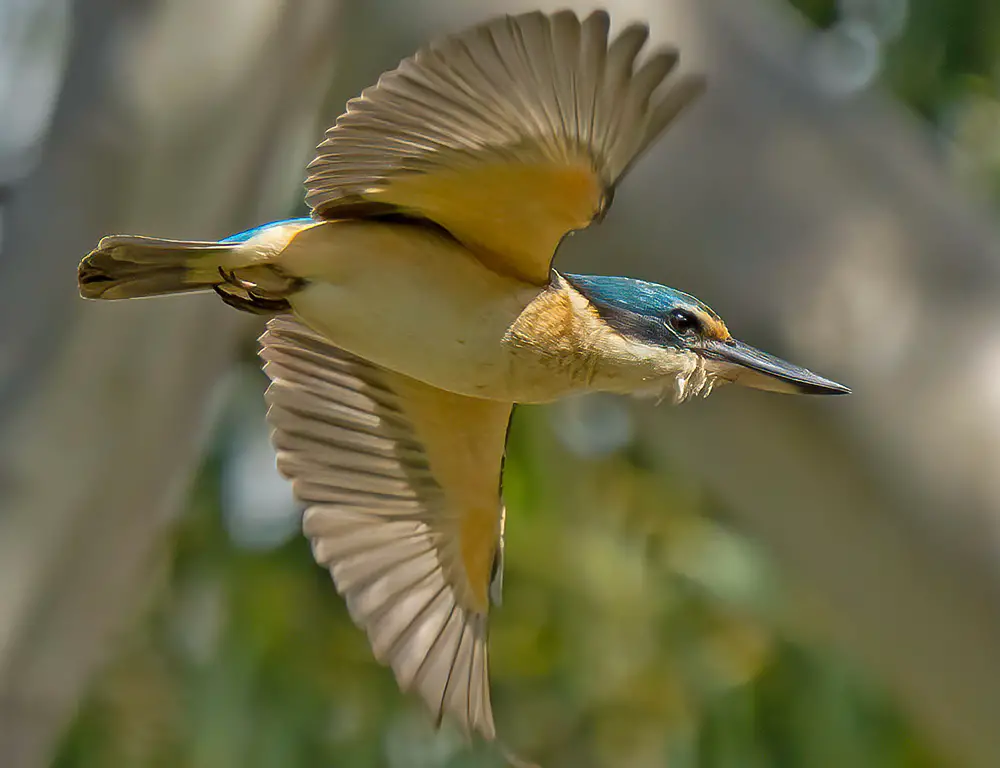
The wings of the Sacred Kingfisher are broad and rounded, allowing for agile flight and effortless maneuverability through dense vegetation.
In flight, the bird’s wings reveal a striking pattern of black and white bars, which serve as camouflage and visual signals during courtship displays. Its tail is short and square-tipped, providing stability during aerial pursuits and abrupt changes in direction.
Legs and Feet
The Sacred Kingfisher’s legs are short and muscular, suited for perching on branches and tree limbs as it scans the water below for potential prey.
Its feet are relatively small but mighty, equipped with sharp claws that enable it to grip slippery surfaces while hunting and to grasp its catch securely.
Sexual Dimorphism
Regarding physical appearance, male and female Sacred Kingfishers are broadly similar, with minor differences in size and plumage coloration. In some subspecies, males may exhibit slightly brighter and more vibrant plumage than females, particularly during the breeding season.
However, these differences are subtle and may vary depending on geographic location and environmental factors.
Juvenile Plumage
Juvenile Sacred Kingfishers display a duller and less vibrant plumage than adults, with muted shades of brown and gray predominating. Their bills are shorter and less robust, gradually developing into the distinctive dagger-like shape characteristic of adults as they mature.
Juveniles may also lack the bold black and white markings present on the wings and tail of adult birds.
Explaining the Life History and Distribution of the Sacred Kingfisher
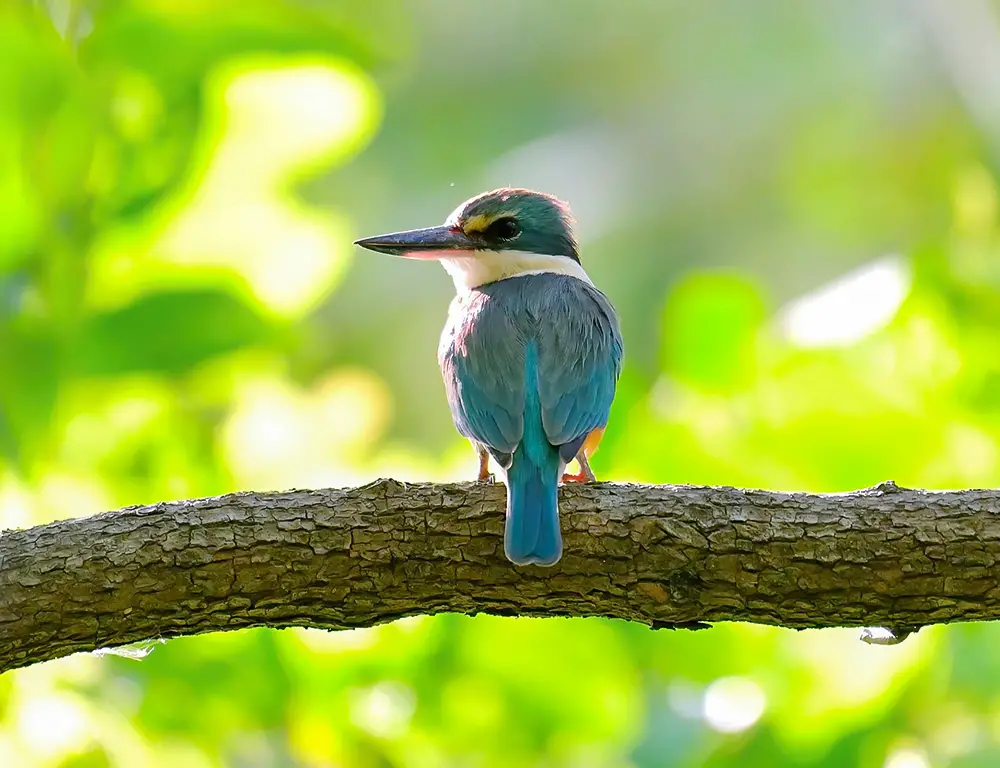
The Sacred Kingfisher symbolizes serenity and natural grace in the tranquil wetlands and lush forests.
Delve into the fascinating life history of this remarkable avian species, from its taxonomy to breeding habits, range, conservation status, and more.
Taxonomy
| Taxonomy Level | Classification |
| Kingdom | Animalia |
| Phylum | Chordata |
| Class | Aves |
| Order | Coraciiformes |
| Family | Alcedinidae |
| Genus | Todiramphus |
| Species | Todiramphus sanctus |
Breeding
The breeding season of the Sacred Kingfisher varies across its range, typically occurring during the warmer months of the year. These birds are cavity nesters, excavating burrows in earthen banks, termite mounds, or soft rotting wood.
The female lays a clutch of eggs, usually between three and six, and both parents take turns incubating the eggs and caring for the young.
Chicks hatch after approximately three weeks of incubation and are fed a diet of small fish, insects, and other aquatic prey brought to the nest by the parents.
Range Map
The Sacred Kingfisher is distributed across a wide range encompassing parts of Australia, New Zealand, Southeast Asia, and the Pacific Islands. Its range extends from coastal regions to inland waterways, mangroves, forests, and grasslands.
The species exhibits seasonal movements within its range, with some populations migrating to more temperate climates during winter.
Social Behavior
Outside of the breeding season, Sacred Kingfishers may form loose flocks, particularly during migration or in areas with abundant food resources.
However, they are generally solitary birds during breeding, defending territories, and nesting sites from intruders.
Adaptations for Aquatic Life
The Sacred Kingfisher has evolved various adaptations for its aquatic lifestyle, including waterproof plumage, specialized bill morphology for catching fish, and excellent aerial agility for diving and capturing prey.
Cultural Significance
In many indigenous cultures, the Sacred Kingfisher holds spiritual significance and is often depicted in art, folklore, and mythology as a symbol of wisdom, prosperity, and harmony with nature.
Conservation
While the Sacred Kingfisher is not currently considered globally threatened, specific populations may face localized threats due to habitat loss, pollution, and human disturbance.
Conservation efforts aimed at protecting wetland habitats, controlling invasive species, and promoting sustainable land management practices are essential for ensuring the long-term survival of this species.
Additionally, continued monitoring of population trends and research into the ecological requirements of Sacred Kingfishers are vital for informed conservation action.
Nesting Habits of the Sacred Kingfisher
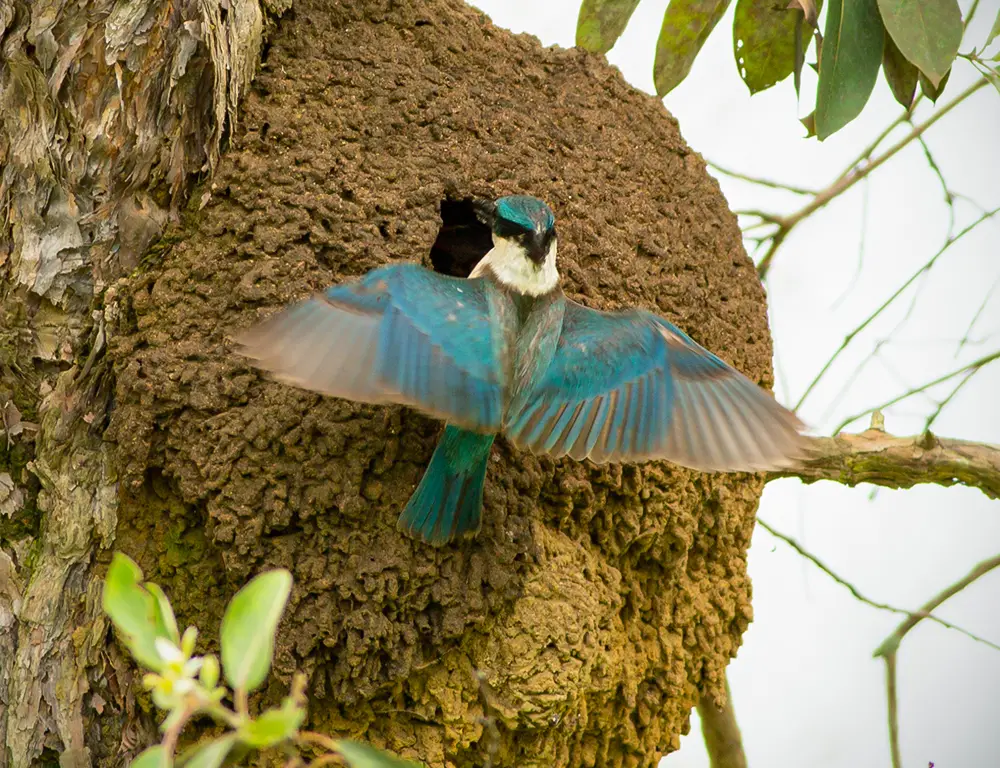
| Nest Type | Description |
| Burrow | Sacred Kingfishers are cavity nesters, excavating burrows in earthen banks, termite mounds, or soft rotting wood. |
| Location | Nests are typically located near water bodies, including rivers, streams, lakes, ponds, and coastal areas. Sacred Kingfishers prefer habitats with suitable nesting sites and abundant food resources. |
| Construction | Sacred Kingfishers typically lay a clutch of three to six eggs, although clutch size may vary depending on habitat quality, food availability, and environmental conditions. |
| Lining Material | The interior of the nesting burrow is usually left unlined, although some individuals may incorporate plant material or feathers into the nesting chamber for added insulation and comfort. |
| Clutch Size | Chicks are altricial upon hatching and depend entirely on their parents for food and care. They proliferate, can flee, and leave the nest after about three to four weeks. |
| Incubation Period | Both parents take turns incubating the eggs, which typically hatch after approximately three weeks. |
| Chick Development | Chicks are altricial upon hatching and depend entirely on their parents for food and care. They increase, can flee, and leave the nest after about three to four weeks. |
What Are the Common Diseases of the Sacred Kingfisher and How to Treat?
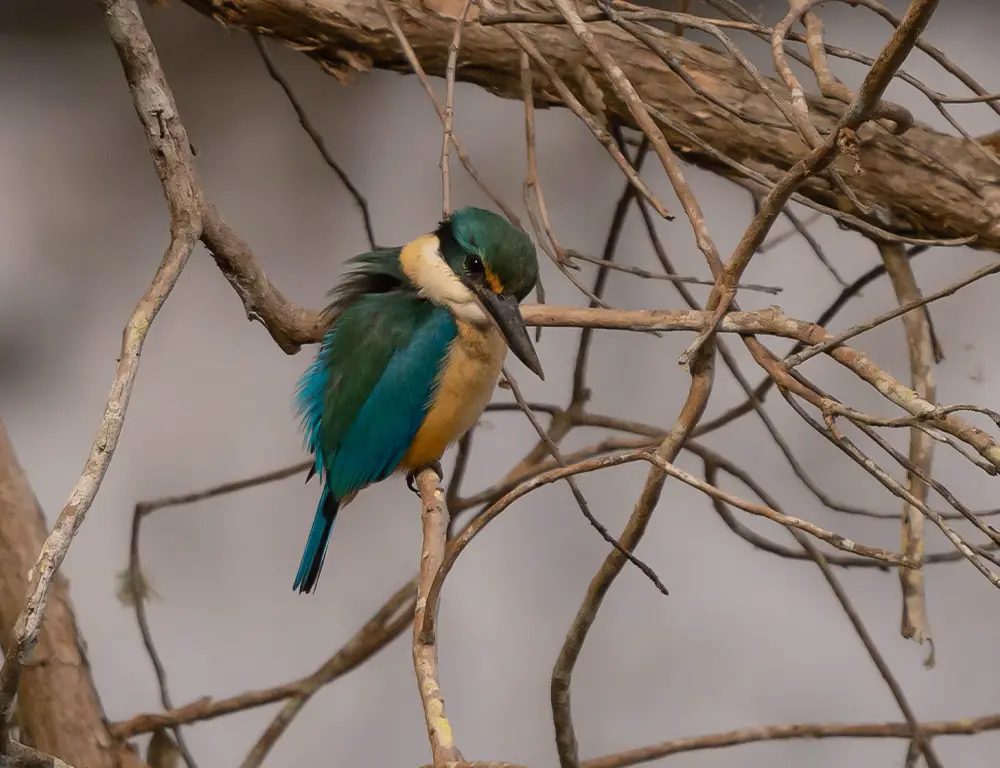
While the Sacred Kingfisher is generally resilient to diseases, they can still be susceptible to various health issues. Some common diseases and health concerns that may affect Sacred Kingfishers include:
Parasitic Infections
External parasites like mites and lice can infest the plumage of Sacred Kingfishers, leading to irritation, feather damage, and potential health problems. Internal parasites such as intestinal worms may also affect their overall health.
Respiratory Infections
Like many bird species, Sacred Kingfishers can be susceptible to respiratory infections caused by bacteria, viruses, or fungi. These infections can lead to coughing, sneezing, nasal discharge, and difficulty breathing.
Nutritional Deficiencies
Inadequate diet or improper nutrition can weaken the immune system of Sacred Kingfishers, making them more susceptible to diseases and health problems.
Deficiencies in essential vitamins, minerals, and nutrients can manifest in various symptoms, including lethargy, poor feather condition, and developmental issues in chicks.
Injuries
Sacred Kingfishers may suffer injuries from collisions with man-made structures, predation, or territorial disputes with other birds. These injuries can range from superficial wounds to more serious trauma affecting internal organs or skeletal structures.
Environmental Stressors
Factors such as habitat loss, pollution, climate change, and human disturbance can contribute to stress and compromised health in Sacred Kingfishers, making them more vulnerable to diseases and other health issues.
Treatment for diseases and health problems in Sacred Kingfishers typically involves a combination of veterinary care, supportive therapy, and environmental management. Here are some general guidelines for treating common diseases:
Consultation with an Avian Veterinarian
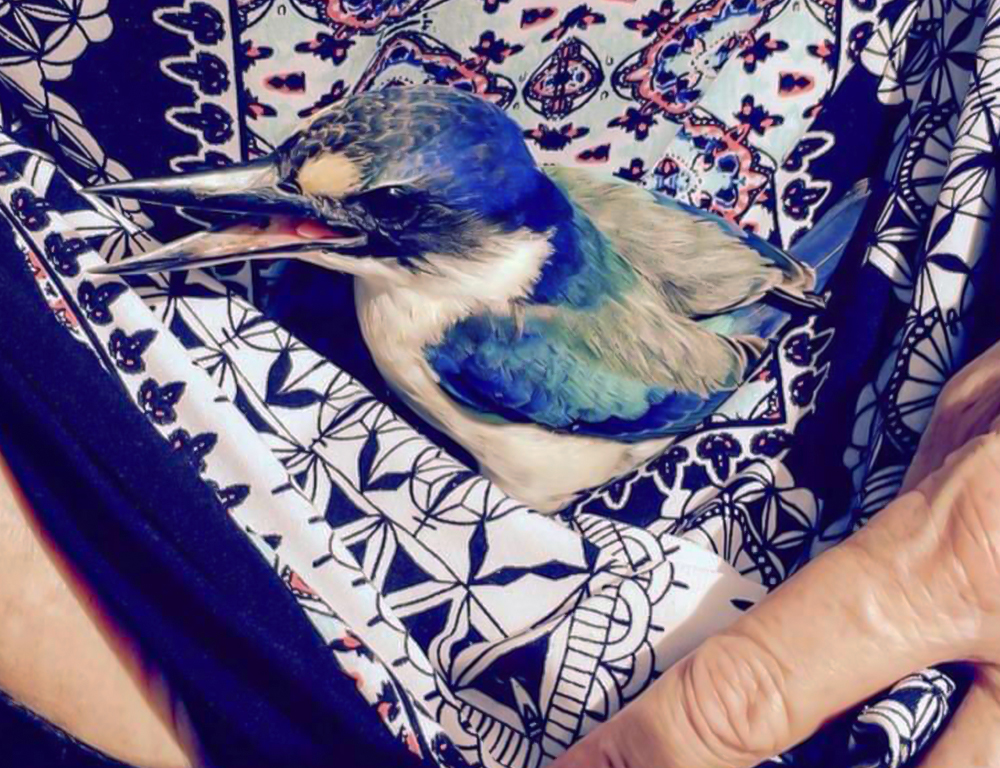
If a Sacred Kingfisher exhibits signs of illness or injury, seeking professional veterinary care from a qualified avian veterinarian is crucial.
A veterinarian can perform a thorough examination, diagnose the underlying cause of the problem, and recommend appropriate treatment.
Parasite Control
External parasites like mites and lice can be treated with topical parasiticides or bathing solutions recommended by a veterinarian. Internal parasites may require deworming medication administered orally or through the diet under veterinary supervision.
Antibiotic Therapy
Respiratory infections and other bacterial diseases may require antibiotic treatment prescribed by a veterinarian.
It is essential to follow the veterinarian’s instructions regarding medication dosage, duration, and administration method to ensure effective treatment and minimize the risk of antibiotic resistance.
Nutritional Support
Providing a balanced diet rich in nutrients is essential for maintaining the overall health and immune function of Sacred Kingfishers.
In cases of nutritional deficiencies, dietary supplementation or modification may be necessary under veterinary guidance.
Environmental Management
Creating a clean, stress-free environment with proper housing, temperature, humidity, and ventilation can promote the recovery and well-being of sick or injured Sacred Kingfishers.
Minimizing exposure to environmental stressors and implementing appropriate husbandry practices are essential for preventing disease outbreaks and maintaining optimal health.
5 Fun Facts About the Sacred Kingfisher
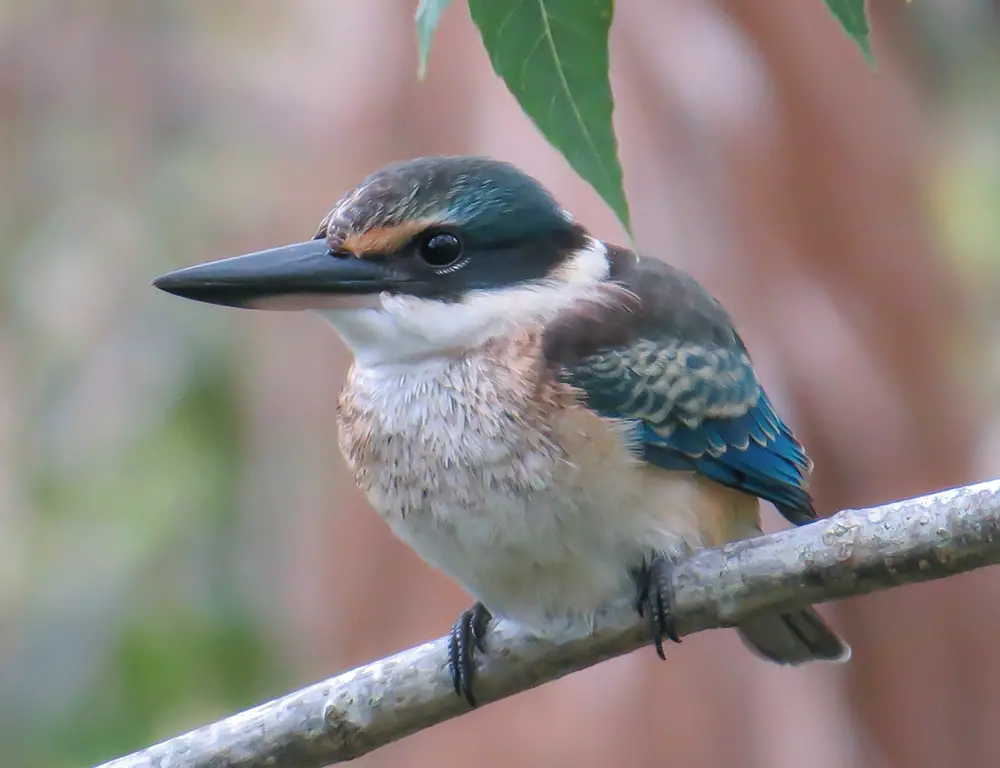
Delve into the Sacred Kingfisher’s fascinating world as we uncover five fun facts illuminating this revered avian species’ remarkable adaptations, behaviors, and cultural connections.
Global Wanderer
Despite its name, the Sacred Kingfisher is not limited to solely catching fish. While it primarily feeds on small fish, it also preys on insects, crustaceans, and even small reptiles and amphibians, showcasing its diverse diet and adaptability.
Mysterious Migrations
Some populations of Sacred Kingfishers undertake seasonal migrations, traveling long distances between breeding and non-breeding grounds. These migratory journeys can span thousands of kilometers and are still not fully understood by scientists.
Acrobatic Hunters
Sacred Kingfishers are skilled hunters, using a sit-and-wait strategy before diving swiftly from perches to catch prey. Their impressive aerial agility allows them to execute precise dives, often returning to the same perch after a successful catch.
Family-Friendly Birds
Unlike some bird species where parental duties are primarily the female’s responsibility, Sacred Kingfishers exhibit shared parental care. Both male and female birds take turns incubating the eggs and feeding the chicks, demonstrating familial solid bonds.
Cultural Significance
In indigenous cultures across its range, the Sacred Kingfisher holds spiritual significance and is often associated with themes of wisdom, protection, and harmony with nature.
Its presence in myths, legends, and artwork highlights its revered status in various cultural traditions.
FAQs
Where can Sacred Kingfishers be found?
Sacred Kingfishers are native to various habitats across Australia, New Zealand, Southeast Asia, and the Pacific Islands. They inhabit coastal regions, wetlands, forests, and grasslands, often near water bodies where they can hunt for prey.
What do Sacred Kingfishers eat?
While their name suggests a diet solely composed of fish, Sacred Kingfishers have a diverse diet. They feed on small fish but consume insects, crustaceans, amphibians, and occasionally small reptiles.
Are Sacred Kingfishers migratory birds?
Some populations of Sacred Kingfishers are migratory, undertaking seasonal movements between breeding and non-breeding grounds. However, not all populations migrate, and the migratory patterns can vary across regions.
Do Sacred Kingfishers mate for life?
Sacred Kingfishers typically form monogamous pairs during the breeding season, and while they may maintain the same mate over multiple seasons, they do not necessarily mate for life. Both male and female birds share parental duties.
What is the cultural significance of Sacred Kingfishers?
Sacred Kingfishers hold spiritual significance in many indigenous cultures across their range. They are often associated with themes of wisdom, protection, and harmony with nature and feature prominently in myths, legends, and artwork.
Conclusion
As we conclude our exploration of the Sacred Kingfisher, we are left in awe of its timeless significance and enduring presence in the collective consciousness of humanity.
From the tranquil waters of Oceania to the ancient forests of Asia, this ethereal creature inspires reverence and wonder.
Through our journey, we have witnessed the Sacred Kingfisher transcend mere ornithological fascination, evolving into a symbol of spiritual enlightenment and harmony with nature.
Its graceful flight reminds us of the interconnectedness of all life forms and the importance of preserving our fragile ecosystems.
As stewards of this planet, let us heed the wisdom of the Sacred Kingfisher, embracing its message of tranquility and unity.
May its legacy endure for generations, guiding us toward a future where reverence for nature and the sacred bonds of existence prevail. In the hushed whispers of the forest, the Sacred Kingfisher’s song still echoes.